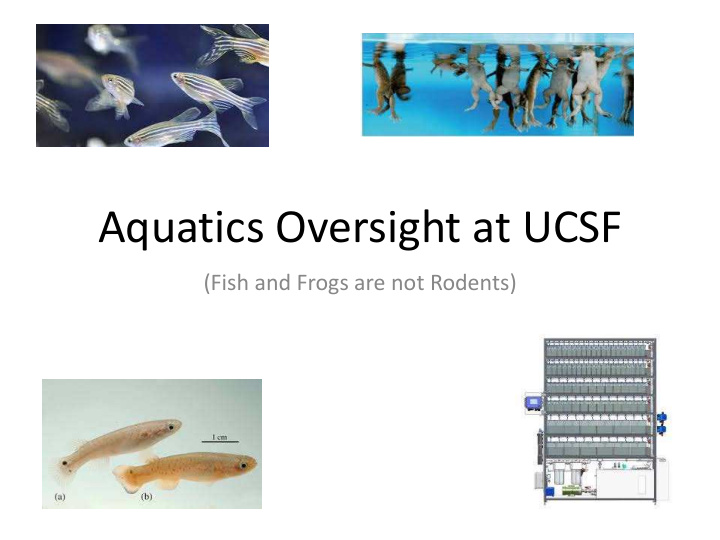



Aquatics Oversight at UCSF (Fish and Frogs are not Rodents)
UCSF: Current Aquatics Lab Care Zebrafish Xenopus tropicalis Mangrove Killifish LARC Care Xenopus laevis Axolotl
Research Use of Aquatics at UCSF Xenopus laevis: Harvest of oocytes as assay for ion channel expression experiments Xenopus tropicalis: Transgenic analysis to determine function of neurodevelopmental disorder-associated genes Zebrafish: Transgenic analysis of many disease processes – neuro, cardiopulmonary, toxicologic Axolotl: Characterization of neurotransmitter receptors and ion channels, electrosensory behavior observation
Regulations Covering Aquatics • The Guide for the Care • NIH – OLAW and Use of Laboratory – Defines vertebrates “at Animals hatching” – Includes larval – AAALAC’s primary amphibians and fish reference standard for accredited institutions in the U.S. • CA Fish and Wildlife – Current edition: – Transgenic fish and frogs expanded information considered detrimental on aquatic animal care species and must be included on a permit
UCSF: Aquatics Policies and SOPs • Policies: – Zebrafish Inclusion in IACUC Protocols • Based on OLAW definition of live vertebrate animals Schiwy et al 2014 “at hatching” => must be counted at 72hpf – Zebrafish (Aquatics) Care Standards • Based on the Guide • Lab SOPs must include all aspects
UCSF: Aquatics Policies and SOPs Aquatics Rodents Zebrafish zygote collection Production of Genetically and crossing Modified Mice Xenopus oocyte harvest (cat D) Tissue Collection for Fin clipping (cat D) Genotyping
Lab Care of Aquatics What are we aiming for? • Demonstrate LARC and lab care of aquatics consistent with centralized care of other animals on campus – Husbandry and recordkeeping – Health care – SOPs – Emergency response – Housekeeping – Occupational Health and Safety
Husbandry and recordkeeping • Housing/Husbandry: – Check tank densities – Check sump tanks – Food in date – Live food managed • Recordkeeping – Feeding/Daily assessment – Water quality monitoring – Room temp/humidity – Mortality – Census : average daily
Health Care • LARC Veterinary Staff – Veterinarians and rodent/aquatics nurses – approx monthly visits to lab facilities – RVTs round aquatics under LARC care – If increased illness or mortality: contact veterinary staff, on call veterinarian • Sentinel testing – Per lab SOP or LARC veterinary advice – Health surveillance data for receiving institutions • Surgery records
SOPs • Should reflect what actually happens • Updated version available in facility • All users familiar with them, can answer questions about them • Most current uploaded to RIO as protocol attachment
Emergency response • Animals checked daily, water environment allows for some leeway before parameters change to a dangerous level • However: – Know ER contacts - should be posted (and accurate) – Water parameter alerts are to reach main users - email or text – Users know how to communicate with Facilities - most aquatics rooms monitored through them
Housekeeping • Clean shelves and floors • Address corrosion • Tank visibility, condition, clean tops, sanitization schedule • Check expiration dates, labels • Food Storage
Occupational Health and Safety • Are you enrolled in the Occupational Health Program? – Answer should be yes – Animal users on the protocol complete a MHS • MS-222: stock solutions made in chemical hood; chemical waste disposal of solutions • Zoonoses: ehs.ucsf.edu/zebra-fish-zoonoses
Summary • Aquatics animals are cool • Aquatic animals are included in the UCSF Animal Care and Use Program • When you are in Aquatic animal facilities under researcher care (most), ask lots of questions about their care
Questions
Recommend
More recommend